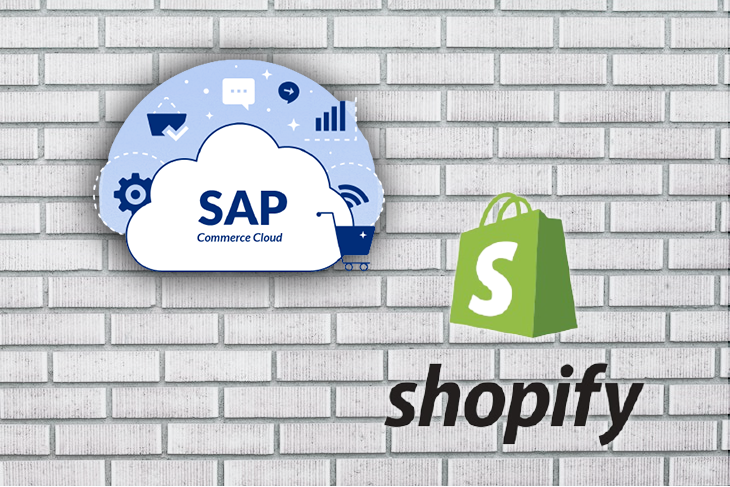
For anyone looking to set up their first online store, understanding facing the large array of ecommerce solutions available today can be a bit daunting. Here, we’ll take a look at two popular ecommerce solutions: the household name Shopify and its lesser-known but robust competitor, SAP Commerce Cloud.


The Replay is a weekly newsletter for dev and engineering leaders.
Delivered once a week, it's your curated guide to the most important conversations around frontend dev, emerging AI tools, and the state of modern software.
Shopify is an ecommerce platform that allows you to set up and sell your products through an online storefront, expand into multiple sales channels — including social media sites and online marketplaces like Amazon and eBay — and harness built-in marketing tools to boost sales and audience engagement.
One of the more popular options, Shopify also provides two distinct advantages for business owners:

One of the world’s largest publicly traded software companies that’s well-known for its enterprise software, SAP offers a robust ecommerce solution called SAP Commerce Cloud. This solution boasts decoupled JavaScript storefronts, easy-to-use tools for content management and order management, and plug-and-play integrations that include a shopping cart, payment services, and tax management.
SAP Commerce Cloud also includes its Context-Driven Services module, a suite of tools to help you tap into real-time individualized customer insights and drive conversions with behavior-based product recommendations and personalized promotions.
The main features business owners look for in an ecommerce solution typically fall into five main categories:
Let’s take a deep dive into what Shopify and SAP Commerce Cloud offer in all of these categories. As you’ll see in the table below, both platforms offer a wide range of features for storefront management, growth and analytics, third-party integrations, cross-platform support, and more.
The optimal solution for you will depend on your personal preferences, business needs, and use cases. Here, we compare each platform’s key features and unique offerings.
The following is a bird’s-eye comparison of the two platforms and their associated features.

Shopify equips store owners with a variety of tools and capabilities to help showcase their products, process payments, and more. Features vary based on the plan selected. There are three main plans: Basic Shopify, Shopify, and Advanced Shopify.
It also offers two spin-off solutions: the enterprise-grade Shopify Plus as well as Shopify Lite, a lightweight plan that allows you to add products to any blog or website and accept credit payments.
For now, let’s take a closer look at the core feature set available to Basic Shopify, Shopify, and Advanced Shopify users.
SAP Commerce Cloud offers an enterprise-grade digital commerce platform equipped with tools that allow store owners to interact with customers, drive initiatives to increase engagement and conversions, and cater internationally to multiple currencies and languages.
According to Datanyze, Shopify currently powers about 270,000 stores, with an approximately 12.68 percent market share. On the other hand, SAP Commerce Cloud powers a little more than 18,000 sites with a 0.85% share. They are the third and 14th most-used ecommerce solutions, respectively.
Other similar platforms include WooCommerce, Squarespace Online Stores, WixStores, Magento, and Amazon.
While both SAP Commerce Cloud and Shopify provide a full, robust range of ecommerce functions, the best solution for you will depend entirely on your organization’s needs and preferences.
Shopify is great for beginners — it’s fairly inexpensive, and its user-friendly interface allows store owners to pick it up almost immediately and get the ball rolling. However, special customizations will require developer knowledge, and the platform can be a bit limited.
On the other hand, SAP Commerce Cloud provides enterprise-level support, including extensive user data and inventory management, and the SAP Commerce Cloud team is available for direct support if needed. The platform also makes localization fairly easy, and features like personalized product recommendations can help maximize conversions and boost sales.
That being said, SAP Commerce Cloud is significantly more expensive than Shopify’s basic plan, offering only quote-based pricing. Its platform, while packed with features and less limited than Shopify’s, has a steep learning curve and requires intensive training to master. This might make the platform less appealing for small business owners.
While Shopify and SAP Commerce Cloud are both comprehensive, full-featured ecommerce platforms, the right solution for you will ultimately depend on your budget, shop preferences, technical knowledge, and support needs.

LogRocket lets you replay user sessions, eliminating guesswork around why users don't convert by showing exactly what users experienced. It captures console logs, errors, network requests, and pixel-perfect DOM recordings — compatible with all frameworks.
LogRocket's Galileo AI watches sessions for you, instantly identifying and explaining user struggles with automated monitoring of your entire product experience.
Start proactively monitoring your ecommerce apps — try LogRocket for free.

VSCode has architectural performance limits. Compare six fast, native code editors built for lower resource usage.

Build a React infinite scroll gallery with TanStack Pacer. Learn debouncing, throttling, batching, and rate limiting without RxJS complexity.

Discover what’s new in The Replay, LogRocket’s newsletter for dev and engineering leaders, in the January 7th issue.

useEffectEventJack Herrington breaks down how React’s new useEffectEvent Hook stabilizes behavior, simplifies timers, and enables predictable abstractions.
Hey there, want to help make our blog better?
Join LogRocket’s Content Advisory Board. You’ll help inform the type of content we create and get access to exclusive meetups, social accreditation, and swag.
Sign up now